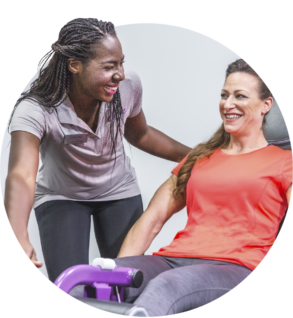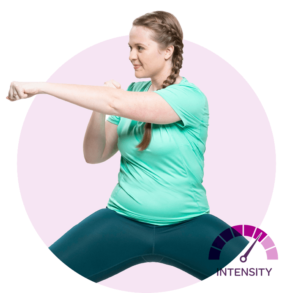Benefits of Pelvic Floor Exercises for Women
Do you see a trampoline and run and hide? Do you sometimes dribble a little before you get to the bathroom to urinate? Is your sex life less stellar than it was a decade ago? If you answered yes to any of these questions, you may have issues with your pelvic floor.
You may not think of your pelvic floor muscles too often, but they are an important part of your life. These muscles support your bladder, intestines, and uterus. When these muscles contract, the openings to your vagina, urethra, and anus tighten. When pelvic floor muscles relax, your body can release urine and feces. Your pelvic floor also plays a role in your sex life. Strong pelvic floor muscles mean less pain during sex and better chances of achieving orgasm. These muscles also help support healthy pregnancy and childbirth.
What are some pelvic floor issues that affect women?
Pelvic floor disorders are common in women and occur when the muscles supporting the bladder, bowel, and uterus become weak or damaged. There are three main types of pelvic floor issues. They include:
- Pelvic organ prolapse, when the uterus and bladder drop into the vagina
- Urinary incontinence, or bladder leakage
- Fecal incontinence, or lack of bowel control 2
What causes pelvic floor problems?
Childbirth is one of the most common causes of pelvic floor disorders in women. Other causes include menopause, obesity, aging, heavy lifting, or previous surgery or radiation to the pelvic area.
What are the symptoms of pelvic floor disorders?
Symptoms of weak or damaged pelvic floor muscles include a sudden urge to urinate, urinary incontinence, failure to empty the bladder, and painful urination. If the muscles around the bowel have been affected, a woman may experience constipation or straining with bowel movements. Other symptoms include pressure or pain in the pelvic area, pelvic muscle spasms, a heavy feeling in the pelvis, or a bulge in the rectum or vagina.
If you’re experiencing symptoms of a pelvic floor disorder, first, see your health care professional. 3 Once you’ve ruled out other causes and concluded that weak pelvic floor muscles are to blame, there’s good and bad news. The bad news is, pelvic floor disorders don’t get better on their own. The good news is that you can do pelvic floor exercises to make these muscles stronger. 4
Benefits of a Strong Pelvic Floor
Just as a weak pelvic floor can put a damper on your quality of life, a strong pelvic floor can do the opposite. With the right women’s fitness program and pelvic floor exercises, you can whip your pelvic floor muscles into tip-top shape and enjoy the following benefits:
- The bladder of a 20-year-old
- Improved posture and less back pain
- Decreased risk of pelvic prolapse
- Better sex life
If these lifestyle benefits sound tempting, it’s time to learn some pelvic floor exercises to make them a reality for you.
The Best Workouts for Women for a Strong Pelvic Floor
If you want a full body workout that targets most major muscle groups—including your pelvic floor muscles—look no further than Curves women’s gym. Curves workouts for women are designed with a woman’s body in mind, to strengthen all muscles, from head to toe. Curves classes, especially Body Basics, which targets the core, are good for strengthening the pelvic floor. Curves now offers the 6-week Strengthen Your Pelvic Floor class as part of the Health and Wellness Education Series. Each course includes dynamic e-learnings, weekly content review, and an extensive library of functional exercises, plus weekly group coaching with a Curves coach in-club or with a community of other women online.
A few of the exercises featured in the Strengthen Your Pelvic Floor class are:
Kegel exercises:
The queen of pelvic floor exercises, Kegels involve contracting and relaxing your pelvic floor muscles. If you leak urine when you laugh, sneeze, cough, or jump, or you have a strong urge to urinate before you go, Kegels are a good pelvic floor exercise for you. To do them:
- Find the right muscles by stopping urination mid-stream. The muscles you use to do this are your pelvic floor muscles.
- Contract these muscles and hold for five seconds, then release for five seconds.
- Do Kegels 10 times, three times a day. 5
Hip Bridge:
Hip Bridges are a good exercise to work the pelvic floor, as well as your hamstrings and glutes. To do a bridge lift:
- Lie on the floor on your back with your knees bent, feet flat on the floor. Place your arms straight at your sides with your palms facing down.
- As you inhale, push down through your heels and raise your hips off the ground. As your hips lift, squeeze your glutes, hamstrings, and pelvic floor muscles. Think of lengthening your thighs and pushing them forward.
- Hold for one to two seconds at the top, then return to the starting position.
- Repeat two to three sets of 10-15 repetitions, resting for 30 to 60 seconds between each set. 6
Both of these pelvic floor exercises are also good parts of a full body workout because they work several muscle groups. Do these pelvic floor exercises as part of a whole body workout for women to improve your pelvic floor muscle strength and your overall quality of life. For more information about the Curves Strengthen Your Pelvic Floor or other Health and Wellness Education Series Classes, visit Curves.com.
And to find out more about how you can informed lifestyle and health choices, visit our blog under the ‘Live’ category! You can also learn more about how the Curves Circuit can benefit your lifestyle here.
Sources:








